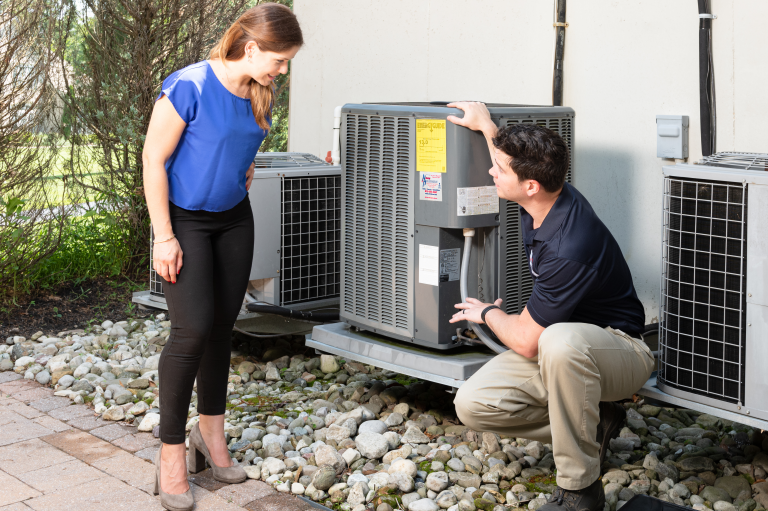Your home’s HVAC (Heating, Ventilation, and Air Conditioning) system plays a crucial role in maintaining comfort year-round. However, like all major home appliances, it won’t last forever. If your system is outdated, inefficient, or constantly needing repairs, it may be time for a replacement. But what exactly does replacing an HVAC system entail? Here’s what you can expect from start to finish.
1. Signs That It’s Time for a Replacement
Before jumping into a new HVAC installation, it’s important to determine whether your current system truly needs replacing. Here are some key indicators:
- Frequent Repairs: If your system is breaking down regularly, the cost of repairs may outweigh the benefits of keeping it.
- Rising Energy Bills: Older systems lose efficiency over time, leading to higher utility costs.
- Inconsistent Temperatures: Struggling to maintain a comfortable temperature throughout your home? Your HVAC system may be failing.
- Unusual Noises or Smells: Strange sounds or persistent odors can indicate serious mechanical issues.
- Age of the System: Most HVAC units last 10-15 years. If yours is older, a replacement could be more cost-effective.
2. Choosing the Right HVAC System
Once you’ve decided to replace your HVAC system, the next step is selecting a suitable replacement. This involves considering:
- Size and Capacity: An HVAC system that’s too small won’t effectively heat or cool your home, while an oversized unit can lead to inefficiency and excess wear. A professional load calculation will help determine the correct size.
- Energy Efficiency Ratings: Look for models with high SEER (Seasonal Energy Efficiency Ratio) ratings to save on energy bills.
- Type of System: You can choose between central air systems, ductless mini-splits, heat pumps, and more, depending on your home’s needs and climate.
- Smart Features: Modern HVAC systems often come with programmable thermostats and smart technology for increased control and efficiency.
3. Preparing for Installation
Before the installation crew arrives, you can take a few steps to prepare your home:
- Clear the Area: Ensure the installation team has easy access to your HVAC unit, thermostat, and ductwork.
- Secure Pets and Kids: HVAC installation involves tools, heavy equipment, and potential hazards, so it’s best to keep pets and young children in a separate space.
- Plan for Noise and Downtime: The process may take several hours or even a full day, so plan accordingly, especially if you work from home.
4. The Installation Process
Here’s what typically happens on installation day:
Step 1: Removal of the Old System
- The technicians will disconnect the old HVAC system, safely removing any refrigerants as required by environmental regulations.
- They’ll then dismantle and remove the old equipment, including the indoor and outdoor units if applicable.
Step 2: Installing the New System
- The team will place the new HVAC unit, ensuring it is properly sized and positioned.
- New ductwork may be installed or modifications made to existing ducts for better efficiency.
- Electrical connections, refrigerant lines, and drainage systems will be set up to ensure proper operation.
Step 3: Testing and Calibration
- Once installed, the technicians will test the system, checking airflow, thermostat calibration, and refrigerant levels.
- Any necessary adjustments will be made to optimize efficiency and performance.
Step 4: Clean-Up and Final Walkthrough
- The team will clean up the work area, removing old components and debris.
- The technician will explain how to use and maintain your new system, including thermostat settings and recommended filters.
5. Post-Installation Considerations
Understanding Your Warranty
Your new HVAC system will likely come with a manufacturer’s warranty covering parts and labor. Be sure to register the unit if required and keep documentation for future reference.
Regular Maintenance Is Key
To ensure your system operates efficiently for years to come, schedule routine maintenance.
This includes:
- Changing filters regularly
- Cleaning vents and ducts
- Having annual professional inspections
Expect an Adjustment Period
A new HVAC system may take some time to get used to, especially if it features smart technology or different airflow patterns than your old unit. Give it a few days to regulate temperatures and optimize comfort.
Final Thoughts
Upgrading your HVAC system is a major investment, but it comes with valuable benefits, including enhanced comfort, improved air quality, and greater energy efficiency. Understanding the replacement process from start to finish can help ensure a seamless transition to a more comfortable and cost-effective home.
If you’re planning an HVAC replacement, consulting a professional contractor is a smart first step. They can evaluate your home’s requirements and recommend the most efficient system for long-term performance. Additionally, if you’re exploring financing options, a HELOC mortgage calculator can help determine how much equity you can leverage to fund your HVAC upgrade, making the investment more manageable.

